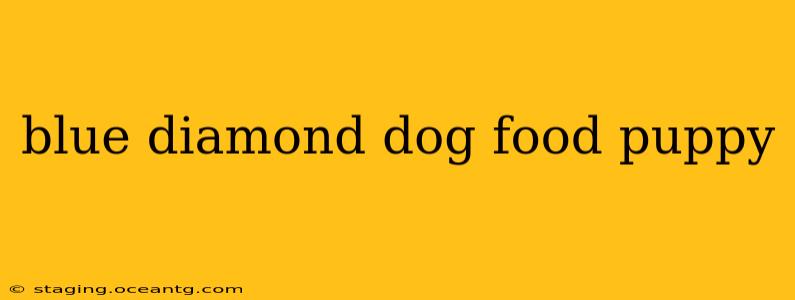Choosing the right puppy food is a crucial decision for every new pet parent. With so many brands on the market, it's easy to feel overwhelmed. This comprehensive review dives deep into Blue Diamond dog food, specifically focusing on its puppy formulas, to help you determine if it's the right choice for your furry friend. We'll explore its ingredients, nutritional benefits, potential drawbacks, and answer frequently asked questions.
What Makes Blue Diamond Dog Food Suitable for Puppies?
Blue Diamond's puppy food formulations are designed to meet the specific nutritional needs of growing puppies. They typically incorporate high-quality protein sources, essential fatty acids for healthy skin and coat, and added vitamins and minerals for overall development. The exact ingredients and nutritional profiles will vary depending on the specific Blue Diamond puppy formula you choose, so always check the label carefully. Look for formulas that list named meat sources (like chicken or lamb) as the primary ingredient, rather than vague terms like "meat by-products."
What are the Key Ingredients in Blue Diamond Puppy Food?
This will vary across different Blue Diamond puppy food lines. However, generally, you can expect to see high-quality protein sources (like chicken, lamb, or fish), healthy carbohydrates (like brown rice or barley), essential fats (like chicken fat or fish oil), and prebiotics and probiotics to support digestive health. Look for the guaranteed analysis on the packaging to see the precise breakdown of protein, fat, fiber, and moisture content. This information helps you compare it to other brands and ensure it aligns with your puppy's needs.
What is the Difference Between Blue Diamond's Different Puppy Food Formulas?
Blue Diamond might offer various puppy food lines catering to different breeds, sizes, or specific health needs (e.g., sensitive stomach). Some might focus on grain-free options, while others may incorporate grains for added fiber. The differences usually lie in the specific protein sources, added nutrients, and overall formulation. Checking the product descriptions and comparing the ingredient lists is essential to selecting the best fit for your individual puppy.
Is Blue Diamond Puppy Food Grain-Free?
Not all Blue Diamond puppy food is grain-free. They offer a range of formulas, some containing grains like rice, barley, or oats, and others that are grain-free. The choice depends on your puppy's individual needs and any potential dietary sensitivities. Grain-free diets can be beneficial for some puppies, but it's important to consult your veterinarian to ensure it's appropriate for your puppy's health.
Does Blue Diamond Puppy Food Contain Fillers?
The presence of fillers varies depending on the specific formula. While Blue Diamond generally aims for quality ingredients, always carefully review the ingredient list. Look for formulas where named meat sources are prominent and fillers such as corn, wheat, or soy are minimal or absent. The higher the percentage of named meat sources, the better the quality.
How Much Blue Diamond Puppy Food Should I Feed My Puppy?
Feeding guidelines are usually printed on the packaging, but these are only general recommendations. The amount of food your puppy needs will depend on their age, breed, size, activity level, and individual metabolism. It's best to consult your veterinarian for personalized feeding advice. Monitor your puppy's weight and adjust the food amount as needed to maintain a healthy weight. Avoid overfeeding, which can lead to obesity and health problems.
Where Can I Buy Blue Diamond Puppy Food?
Blue Diamond dog food is available at various pet stores, both online and in physical locations. Check your local pet supply stores, or search online retailers for availability in your area.
This comprehensive overview aims to provide a detailed look at Blue Diamond puppy food. Remember to always consult with your veterinarian before making any significant changes to your puppy’s diet. They can provide tailored advice based on your puppy’s specific breed, age, health status, and any potential dietary requirements.
